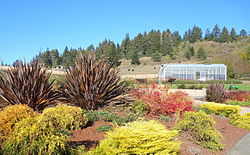| Humboldt Botanical Garden | |
|---|---|
 | |
 Interactive map of Humboldt Botanical Garden | |
| Type | Botanical Gardens |
| Location | 7707 Tompkins Hill Road, Eureka, California (garden); 402 E Street, Eureka, California (business office) |
| Nearest city | Eureka, California |
| Coordinates | 40°41′49.11″N124°12′0.81″W / 40.6969750°N 124.2002250°W Near highway 101 and adjacent to the College of the Redwoods campus |
| Area | 44.5 acres |
| Elevation | 100 feet; varying |
| Established | 2003 |
| Designer | Ron Lutsko |
| Operated by | Humboldt Botanical Garden Foundation |
| Open | Daily 10:00 am until 5:00 with no entrance after 4:00 pm (November 1 through March 31, 10:00 am until 4:00 pm with no entrance after 3:00 pm). Dogs allowed on leash for an additional fee. Gardens may be booked as an events venue. |
| Camp sites | No |
| Hiking trails | 5 miles of hiking trails |
| Terrain | Mediterranean and Pacific Marine hill and dale allows for an arid Native Plant Garden, fern glade, woodlands, etc. |
| Water | Streams |
| Collections | Native conifer, Iris, and western lily (Lilium occidental) |
| Parking | Free parking at the entrance |
| Other information | Member of the American Public Gardens Association, the American Rhododendron Society, and the American Horticultural Society Reciprocal Admissions program |
| Website | hbgf |
The Humboldt Botanical Garden is a 44.5 acres (18 ha) botanical garden located four miles south of Eureka, California, United States. [1] [2] The Garden is near the South Bay portion of Humboldt Bay on the north side of the College of the Redwoods. [3] Grading and site preparation began in August 2003. Featuring views of Humboldt Bay and the Pacific Ocean, [4] [5] the garden opened in 2006, with more development completed by 2008.
Contents
The Humboldt Botanical Garden (HBG) business office is located in downtown Eureka and is operated by the nonprofit Humboldt Botanical Garden Foundation which had over 1000 members in 2020. [1] HBG is a member of the American Public Gardens Association, the American Rhododendron Society, and the American Horticultural Society Reciprocal Admission program. [6] [7]
The garden is "a repository for many rare and hard to grow rhododendrons and their companion plants" according to a local office of the American Rhododendron Society. [8] HBG is listed by the California Native Plant Society as one of the 17 California gardens with notable California native plant collections. [9]


The Gardens were first organized in 1991. [1] Originally a farm, the site is a grassy escarpment with meadows and woodland, and a year-round stream. [10] The area's climate, which straddles Mediterranean and Pacific Marine [10] allows for a diverse group of plants. [1] Its Native Plant Garden has an emphasis on the Humboldt region, but includes plants from other geographic areas. Other gardens are: "All Happy Now" earth sculpture, meant to be walked in the way of meditation labyrinths; [10] Riparian Area; Greenhouse; the Temperate Woodland Garden; the Ornamental Terrace Garden; [11] Rose Garden; Heather Garden; Pollinator Garden; [12] Mediterranean Allee and Native Tree garden; [10] plus five miles of hiking trails. [13]
The Humboldt Botanical Garden is particularly interested in maintaining complete native conifer, Iris and western lily ( Lilium occidental) collections. Its Mission Statement is: To cultivate a garden that provides an enjoyable discovery into the botanical world through education, participation and community service. [14]
A summer music series and an annual native plant sale are held in the gardens. [15] The gardens are available as a special events venue. [4]
